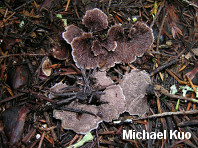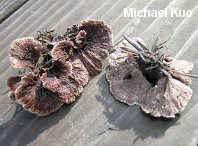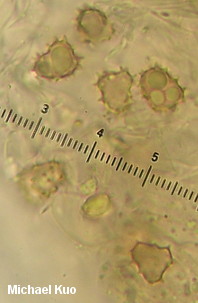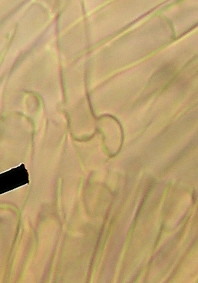| Major Groups > Crust Fungi > Thelephora terrestris |

|
Thelephora terrestris [ Basidiomycota > Thelephorales > Thelephoraceae > Thelephora ... ] by Michael Kuo Thelephora terrestris is an odd, spreading fungus that crawls through forest litter under conifers, making fan-shaped caps in little clusters and rosettes. The caps are typically a shade of fairly dark brown, with whitish margins (when fresh); the undersides of the caps are bald but wrinkled, often into tight little bumps. Under the microscope, Thelephora terrestris features angular, spiny spores and brownish, clamped tramal elements. Thelephora americana can be similar in appearance, but features lighter shades of brown and, more definitively, associates with hardwoods. Our North American version of Thelephora terrestris is probably not actually the same as the true, European version originally described in the 18th century. Thelephora species are currently defined on the basis of species concepts from the heyday of micro-morphology (primarily Corner, 1968). The few DNA studies that have been focused on the genus at the species-level (e.g. Ramírez-López et al., 2015) reveal the potential for hidden species and significant variability in morphological features within species in the genus. Description: Ecology: Mycorrhizal with conifers (but also documented by Ingleby & Mason, 1996, with eucalyptus); spreading terrestrially and forming single to gregarious or (more often) clustered fruiting bodies; summer and fall (and over winter in warm climates); widespread and common in North America. The illustrated and described collection is from California. Fruiting Body: A spreading mass of cap-like structures 2-4 cm high, often fused laterally and/or forming rosettes. Caps: 2-4 cm across; centrally depressed; fan-shaped to semicircular; radially wrinkled and grooved; dry; fibrillose to velvety; shades of dark brown, with a whitish margin when fresh; vaguely zoned. Undersurfaces: Wrinkled or, with age, compressed into small bumps that are vaguely radially arranged; grayish brown; bald. Flesh: Tough; about 2 mm thick; brownish; unchanging when sliced. Odor: Not distinctive. Spore Print: Brown. Microscopic Features: Spores 7-10 x 5-6 µ (excluding ornamentation); angular; covered with spines that extend 0.5-1 µ; brownish in KOH. Subhymenium not bluing in KOH. Tramal hyphae cylindric; 2-4 µ wide; walls slightly thickened, smooth, and brownish to brown in KOH; often clamped at septa. REFERENCES: J. F. Ehrhart, 1787. (Fries, 1821; Saccardo, 1888; Corner, 1968; Smith, Smith & Weber, 1981; Arora, 1986; Breitenbach & Kränzlin, 1986; Phillips, 1991/2005; Lincoff, 1992; Stalpers, 1993; Ingleby & Mason, 1996; Barron, 1999; McNeil, 2006; Miller & Miller, 2006; Trudell & Ammirati, 2009; Desjardin, Wood & Stevens, 2015.) Herb. Kuo 01151104. This site contains no information about the edibility or toxicity of mushrooms. |
© MushroomExpert.Com |
|
Cite this page as: Kuo, M. (2015, December). Thelephora terrestris. Retrieved from the MushroomExpert.Com Web site: http://www.mushroomexpert.com/thelephora_terrestris.html |



